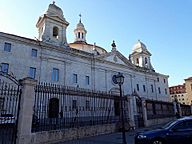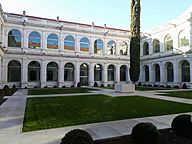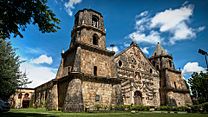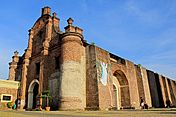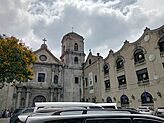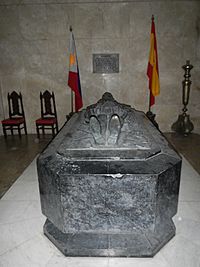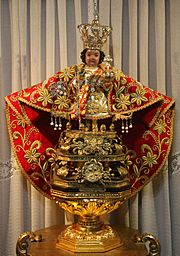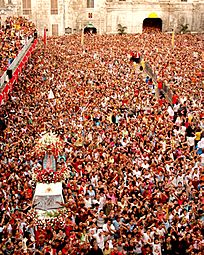Augustinian Province of the Most Holy Name of Jesus of the Philippines facts for kids
The Province of the Most Holy Name of Jesus of the Philippines was a special group of Augustinian priests and brothers. They were part of the larger Order of St. Augustine. This group was officially formed on March 7, 1575. Its main job was to support the Augustinians working in the Philippines. In the 16th century, these Augustinians served people in over 300 towns across the islands.
Later, in the 20th century, the Province grew and helped communities in other parts of the world, including East Asia, Africa, and the Americas. It became the largest province within the Augustinian Order. In 2018, it had more than 300 Augustinian friars working in many countries like the Philippines, Spain, Tanzania, India, Venezuela, Peru, Costa Rica, El Salvador, Honduras, and China.
This Province officially ended on September 16, 2019. It joined with three other Spanish Augustinian Provinces in Rome. Together, they formed a new, united Spanish Augustinian Province called San Juan de Sahagun. This change aimed to make the Augustinian Order in Spain stronger.
Contents
- The Spanish Exploration in the Philippines
- Augustinians: First Missionaries in the Philippines
- Forming a New Augustinian Province
- Augustinian Contributions and Works
- Augustinian Work in Asia and Beyond
- The Province: A "Mother" to Other Augustinian Groups
- The Province of Santo Niño de Cebu and The Augustinian Vicariate of the Orient
- Former Groups of the Province of the Most Holy Name of Jesus of the Philippines of Spain
- The Joining of Augustinian Provinces in Spain
- See also
The Spanish Exploration in the Philippines
In 1565, Miguel López de Legazpi arrived in the Philippines. He led an expedition sent by the Viceroy of New Spain. Their goal was to find islands west of the Moluccas, following orders from King Philip II of Spain. A famous navigator named Andrés de Urdaneta (born 1498, died June 3, 1568, in Mexico) was chosen to guide this difficult journey. He was also an Augustinian friar.
Father Urdaneta had traveled across the Pacific Ocean before. However, he did not want to join this new trip, especially not to lead it. He was already in his sixties and not in good health. He felt he had retired from being a navigator after joining the Augustinian Order in Mexico.
When King Philip II ordered his men to focus on the Philippines, it was also to avoid more fights with the Portuguese. Portugal was Spain's main rival during this time of exploration. When the King asked Urdaneta to guide the voyage, Urdaneta felt he had to obey. He did it for "the glory of God and the expansion of our faith." Urdaneta's skills and past experiences were very important for keeping the expedition on track.
Augustinians: First Missionaries in the Philippines
Urdaneta and four other Augustinians arrived in Cebú in April 1565. They quickly started their religious work. Legazpi founded the first Spanish settlement there. His men found a statue of the Child Jesus in a burned hut. The Spaniards thought it was a miracle. This statue was a gift from Ferdinand Magellan to the wife of the rajah of Cebu in 1521. Legazpi named the place Villa del Santísimo Nombre de Jésus to honor the Holy Child.
Urdaneta founded the first churches in the Philippines, including the St. Vitales Church and the Basilica del Santo Niño. He was the first leader of the Church in Cebu. Urdaneta was known as a "protector of the Indians" because he treated the Filipino natives well. In June 1565, he and Andrés de Aguirre went back to Mexico City to report on their experiences. In 1567, he wanted to return to the Philippines, but his superior said no because of his age. He died in Mexico City on June 3, 1568.
Forming a New Augustinian Province
When Urdaneta and Aguirre returned to Mexico, three other Augustinians stayed. They quickly learned the local Cebuano language. In 1566–67, one of them, Martín de Rada, traveled to nearby islands to preach. In Manila, the Augustinians received land inside the walled city of Intramuros. There, they built a church and a monastery. The first San Agustin Church, made of bamboo and nipa, was finished in 1571.
First Provincial Meeting
The first important meeting of the Province of the Most Holy Name of Jesus of the Philippines happened at San Agustin Church on May 3, 1572. At this meeting, Fray Martin de Rada was chosen as the first leader of the province. Rada spoke out against the unfair actions of Spanish officials towards the local people. He reported these problems to King Philip II. Because he strongly fought for justice, he is remembered as the "Defender of the Natives."
Official Establishment of the Province
In 1575, 24 more Spanish Augustinians arrived in the islands, led by Father Alfonso Gutierez. With help from Fathers Herrera and Rada, they worked very successfully as traveling preachers. Their strong desire to spread their faith played a big part in the Philippines becoming the only Catholic nation in Asia today.
In 1575, the head of the Augustinian Order, Fr. Tadeo de Perusa, officially created the new Augustinian Province in the Philippines. It was named the Province of the Most Holy Name of Jesus of the Philippines. To make sure there were always enough missionaries for the Philippines, a special school was set up in Valladolid, Spain. Other religious groups, like the Franciscans, Dominicans, and Jesuits, also arrived later and were welcomed by the Augustinians.
Discalced Augustinians Arrive
The first Discalced Augustinians (a stricter branch of the Order) arrived in 1606, sent by King Philip III. All these religious Orders worked together in the missions. Spain protected them, and their missionary efforts became more and more successful. However, in 1773, the Jesuits had to leave their missions because their Society was closed down.
Main Base of Operations
San Agustín Church and Monastery served as the main office for the province for over 300 years. It is also where Miguel López de Legazpi is buried.
Augustinian Contributions and Works
The missionaries of the Province wrote important books about Asian countries and their people, especially in the early days. For example, Father Cipriano Navarro wrote a valuable book called The Inhabitants of the Philippines. Father Manuel Blanco created a huge six-volume work called Flora de Filipinas (Madrid, 1877--). Both books are important contributions to knowledge. Father Blanco, a world-famous botanist, built a botanical garden in Intramuros for his plant experiments. This garden became the basis for his famous book. Augustinian friars also studied the languages of the Philippine Islands. Many wrote grammar books and put together dictionaries.
Spreading the Faith in Native Settlements
In Luzon, the Augustinians started spreading their faith in native villages. They later built churches in many towns. These included Calumpit, Malolos, Hagonoy, Bigaa, Guiguinto, and Quingua in the province of Bulacan. They also built churches in Lubao, Betis, Macabebe, Bacolor, San Fernando, and Apalit in the province of Pampanga.
Augustinian Work in Asia and Beyond
From 1565 until recently, over 3,000 Augustinian missionaries worked hard in the Philippines, China, and Japan. The Augustinian missions in the Philippines sent missionaries to other parts of East Asia from the very beginning. In 1603, some went to Japan, where several were killed for their faith. In 1653, others reached China, and by 1701, the Order had six mission stations there. Father Rada was one of those who visited China. He wrote detailed reports about what he saw and thought about the country. He is seen as the first ambassador from the Philippines to China during colonial times.
Before the Philippine Revolution of 1896, the Augustinians managed over four hundred schools and churches across the Philippine islands. In 1904, they started the University of San Agustin in Iloilo City. This university grew to become the largest Augustinian school in the world by student numbers. It is also the only Augustinian university in the Asia-Pacific region. The Augustinians have also been the guardians of the Santo Niño Shrine in Cebu City. This shrine houses the very old image of the Child Jesus that Legazpi's men found in 1565. It is located within the Basilica del Santo Niño de Cebu.
On August 12, 1879, Pope Leo XIII asked the Augustinians of the Philippines Province to take on the mission in Northern Hunan, China. The Augustinians set up main mission stations in three areas: Changteh (now Changde), Lichow (now Lixian), and Yochow (now Yueyang). Because of their efforts, this mission became an Apostolic Vicariate (a type of church district) in September of the same year. It later became the Diocese of Changde in 1946. Several Augustinians from the Philippines Province served as church leaders there.
In 1968, the Province also restarted the Augustinian presence in India. Augustinian missionaries first reached India through Goa in 1542. Interestingly, four of these early missionaries became the first priests from a religious order to sail all the way around the world.
In the past, the Province sent missionaries from its houses in Spain and its missions in the Philippines to Brazil, Colombia, Peru, and Venezuela. More recently, it was also actively involved in training and sending missionaries to Tanzania.
The Province: A "Mother" to Other Augustinian Groups
Throughout its history, the Province of the Most Holy Name of Jesus of the Philippines helped create other Augustinian groups around the world. These groups needed more help to serve their communities. Since it was the biggest province in the Order, it helped and supported provinces in Brazil, Castille, Spain, Colombia, and Peru. This help allowed these provinces to become strong again. The most famous province that came from the Philippines Province is the Augustinian Province of Santo Niño de Cebu, which is based in the Philippines.
The Province of Santo Niño de Cebu and The Augustinian Vicariate of the Orient
Around the year 1900, the Province of the Most Holy Name of Jesus of the Philippines decided to focus its missionary work on newer areas like Peru, Colombia, and Venezuela. Because of this, their presence in the Philippines became smaller. In 1926, it was reduced to a "Vicariate" (a smaller church area) called the Augustinian Vicariate of the Philippines. This was done to keep a Spanish presence in the country. The main office of the Spanish province moved from San Agustin in Intramuros to Madrid, Spain. The number of Augustinians in the Philippines became very small.
To make up for this, the remaining Augustinians worked harder to find and train Filipino candidates. As more Filipinos joined and were ready, the idea of creating a new Province became serious.
Plans for this new Province started in 1974. Filipino Augustinians met in Cebu in 1981 and decided to push for a new Province. This new Province would be called the Province of Sto. Niño de Cebu-Philippines. The idea was officially supported by the Augustinian leaders in the Philippines in August 1981. It was also approved by the main Province in Spain in July 1982. The plan was strongly approved by the Augustinian Order's General Chapter in Rome on September 15, 1983. The new province was officially created on December 25, 1983.
The Province of Cebu was officially formed on September 13, 1983, in Rome. Ninety-three delegates approved the creation of the first Augustinian province led by local people in Asia. This happened after over 400 years of control by Spanish religious leaders.
Even before the new province was set up, the Spanish Province and the Augustinian Order decided to create a new vicariate. This was called The Augustinian Vicariate of the Orient. Its purpose was to continue the historical and cultural identity of the Spanish province in the Philippines. This new vicariate also had a new mission: to spread the Good News of Jesus Christ and to teach people in Eastern and Southeastern Asia. It also aimed to reconnect with missions in China and India.
When the new Province of Cebu was founded, two communities in the Philippines stayed with the Vicariate of the Orient: San Agustin Church in Intramuros, Manila, and Colegio San Agustin in Makati. Two other communities in India and one church in Hunan, China, were also given to the Vicariate. All other Augustinian communities in the Philippines at that time went to the Province of Cebu. Because of the birth of the new Filipino province, the original Spanish Province had to change its name. It became the Province of the Most Holy Name of Jesus of the Philippines of Spain to show it was different from the new Filipino Province of Cebu.
Former Groups of the Province of the Most Holy Name of Jesus of the Philippines of Spain
Here is a list of the groups that were part of the Province of the Most Holy Name of Jesus of the Philippines of Spain:
- The Group in Spain (Spain)
- The Augustinian Vicariate of the Orient (Philippines and China)
- The Augustinian Vicariate of Our Lady of Grace (India)
- The Augustinian Vicariate of Iquitos (Peru)
- The Augustinian Vicariate of Venezuela (Venezuela)
- The Augustinian Delegation of Tanzania (Tanzania)
- The Augustinian Delegation of Centroamerica (Central America)
The Joining of Augustinian Provinces in Spain
The Province of the Most Holy Name of Jesus of the Philippines of Spain officially joined with three other Spanish Augustinian Provinces on September 16, 2019, in Rome. These were the Province of Castille, the Province of the Sacred Heart of Jesus of Matritense, and the Province of the Most Holy Name of Jesus of Spain. Together, they formed a new, united Spanish Augustinian Province called St. John of Sahagun. This was done to help the Augustinian Order in Spain, which had been getting smaller.
Because these provinces joined, some of their groups changed. For example, the Augustinian Vicariate of the Orient became The Augustinian Province of the Most Holy Name of Jesus of the Philippines. This is a new, separate province from the Province of Cebu, and it took the old name of the Spanish Province of the Philippines. Also, the Delegation of Tanzania became The Augustinian Vicariate of Tanzania.
See also
 In Spanish: Agustinos filipinos para niños
In Spanish: Agustinos filipinos para niños
- Augustinian Province of Santo Niño de Cebu
- University of San Agustin


